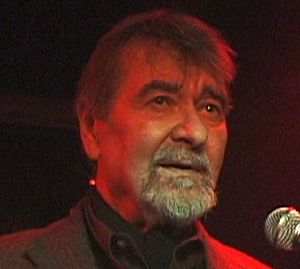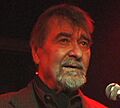Giorgio Gomelsky facts for kids
Quick facts for kids
Giorgio Gomelsky
|
|
|---|---|

Gomelsky in 2009
|
|
| Background information | |
| Born | 28 February 1934 Tiflis, Georgian SSR, Soviet Union |
| Died | 13 January 2016 (aged 81) New York City, New York, U.S. |
| Occupation(s) | Music manager, record producer |
| Years active | Mid-1950s–2016 |
| Labels |
|
| Associated acts |
|
Giorgio Gomelsky (born February 28, 1934 – died January 13, 2016) was a very important person in the music world. He was a filmmaker, a music manager, a songwriter, and a record producer. He was born in Georgia, grew up in Switzerland, and later lived in the United Kingdom and the United States.
Giorgio owned a famous club in London called the Crawdaddy Club. The band The Rolling Stones started there as the main band. He helped them a lot in their early days. Later, he hired The Yardbirds to play at the club and became their manager and producer.
In 1967, he started his own record company, Marmalade Records. This label helped launch the careers of artists like Brian Auger, Julie Driscoll and the Trinity, and Blossom Toes. He also helped bands like Soft Machine, Gong, and Magma become famous.
Contents
Early Life and Music Discovery
Giorgio Gomelsky was born in Tiflis, which is now Tbilisi, Georgia. His father was a doctor. His family moved from Georgia in 1938. After traveling through Syria, Egypt, and Italy, they settled in Switzerland in 1944.
When Giorgio was 10, he discovered jazz music while living in Italy. He found some jazz records in an attic and loved the sound. After the war, American soldiers helped him learn even more about jazz.
He went to a school in Ascona, Switzerland. He and his friends started collecting records. By 1946, he listened to jazz music on the radio from the Voice of America. Later, in 1964, he even organized a jazz festival in Ascona.
Giorgio also went to a special school in the Swiss mountains. During holidays, he rode his bicycle around Europe with friends. They found lively jazz clubs in cities like Düsseldorf and even traveled to Paris to see the famous jazz musician Charlie Parker.
His mother was a hat designer. She loved English culture and sent Giorgio English music papers like Melody Maker. This helped him learn English and about the British jazz scene.
At that time, it was hard to hear new jazz music in Europe. So, Giorgio and his friends started jazz fan clubs. They even formed a band, with Giorgio playing drums. He had to rent a drum kit for every show because he only owned one cymbal!
Giorgio helped create a Swiss group of jazz clubs. In 1954, they organized a protest when they weren't allowed to hold a concert. This led to the start of the Zurich Jazz Festival, which still happens today.
After becoming a Swiss citizen, Giorgio had to join the military. He trained with the Swiss Air Force and flew planes. He then left the country to follow his passion for music.
Filmmaking in England
Giorgio loved reading Melody Maker and decided he wanted to film the growing jazz scene in the UK. He got money from an Italian TV station and moved to England.
In London, he worked with the National Jazz Federation. He filmed famous jazz musicians like Chris Barber. His first film was well-received. Two years later, he filmed Chris Barber again using three cameras.
Giorgio also helped at the first National Jazz and Blues Festival in 1959. He got permission to film the 1960 festival. He used four cameras and recorded the sound separately.
The Rise of British Rhythm & Blues
Chris Barber's band helped start the skiffle music trend. Later, Barber began playing blues music. He worked with musicians like Alexis Korner and Cyril Davies.
Alexis Korner wanted to play a more modern, electric blues sound. He formed his own band, Alexis Korner Blues Incorporated. Giorgio was very excited about this new sound. He even came up with the name "BRB" for British Rhythm and Blues.
Alexis and Cyril had a small blues club. Giorgio helped them get a bigger place at The Marquee club. At first, only a few people came. But then, some famous people visited, which made the club very popular.
Giorgio wanted to organize more blues shows. He encouraged bands to work together to get bookings. He then found another club, the Cy Laurie Piccadilly Club. He held the first festival of British blues there. Bands like Alexis Korner's Blues Incorporated and The Rolling Stones played. Giorgio even had friends stand in line outside to make it look like a big crowd!
The Crawdaddy Club Story
Giorgio believed that new, young fans were key to the future of blues music. He thought bands needed to play regularly in one place to build an audience. So, he decided to open a club outside central London.
He found the Station Hotel in Richmond, a suburb of West London. He knew that the nearby Kingston Art School had many music fans. The Rolling Stones were given the first regular spot. On the first night, only three people showed up! Giorgio had accidentally written "Rhythm & Bulls" on the sign.
But the Rolling Stones were talented. Giorgio also offered free entry to anyone who brought two friends. Soon, the club was packed. He also convinced the Stones to play a long, exciting version of the song "Crawdad" at the end of their shows. This became a highlight.
Giorgio took on much of the work managing and promoting the Rolling Stones. He got a local newspaper, The Richmond and Twickenham Times, to write about the band. He also planned to make a short film about them.
While editing the film, he got a call asking for the club's name. Inspired by the song "Crawdad," he quickly came up with "The Crawdaddy."
A full-page article about the club appeared in the local paper. Giorgio showed it to a music critic from the Daily Mirror, a big national newspaper. Soon, a half-page story about the Crawdaddy Club appeared in the Mirror. The hotel owners were not happy about the article and asked the club to leave.
Giorgio had to go to Switzerland because his father passed away. While he was gone, his friend Hamish Grimes found a new home for the club. It moved to a bigger room below the grandstand at the Richmond Athletic Association grounds, just a block away.
When the Rolling Stones became too famous for small clubs, The Yardbirds took over their spot at the Crawdaddy. Other famous artists like Led Zeppelin, Elton John, and Rod Stewart also played there. In the 1960s, Giorgio managed and produced The Yardbirds. He also started Marmalade Records and worked with many other musicians like Julie Driscoll, Jeff Beck, and Soft Machine.
He helped British rock musicians record with American blues artists. For example, The Yardbirds recorded with Sonny Boy Williamson II, who even stayed at Giorgio's place for a while.
In the 1970s, Giorgio became involved with progressive jazz-rock bands like Gong and Magma.
Later Years in the United States
In the mid-1970s, Giorgio visited New York City and felt like he had found his home. In 1978, he moved to New York to help European jazz-rock bands become known in America. He opened the Zu Club in Manhattan.
He met a young bass player named Bill Laswell and encouraged him to form a band. This band became known as the Zu Band. They later worked with Daevid Allen from the band Gong and performed as 'New York Gong'. The band eventually became Material. Their first recording was an EP called Temporary Music 1 for Giorgio's Zu Records.
From 1978 until the 2010s, Giorgio continued to help and guide musicians from his studio in New York City. He organized special music nights where new bands played. He also worked as a DJ, playing new African and experimental jazz music. In the 1980s, he was a pioneer in digital video and won awards for his work.
Giorgio also helped bring the important Czech band, The Plastic People of the Universe, to international attention. He organized a concert for their lyricist in 1989. News of this concert is said to have helped inspire the Velvet Revolution, a peaceful movement for change in Czechoslovakia.
Giorgio supported many New York bands, including D Generation and Band of Susans.
Production Work
Giorgio Gomelsky helped produce many recordings, including:
- Soft Machine's first demo tapes.
- Gong's albums Flying Teapot and Angel's Egg (both from 1973).
- Aphrodite's Child's album 666 (1972).
- Vangelis's albums Hypothesis and The Dragon (1971), which were released later.
Death
Giorgio Gomelsky passed away from cancer on January 13, 2016, in New York City. He was 81 years old.
Biography
In 2018, actor and musician Francis Dumaurier wrote a book called For Your Love. It included a biography of Giorgio Gomelsky and memories from his friends.
See also
 In Spanish: Giorgio Gomelsky para niños
In Spanish: Giorgio Gomelsky para niños
- Romantic Warriors II: A Progressive Music Saga About Rock in Opposition
- Romantic Warriors II: Special Features DVD
- Romantic Warriors III: Canterbury Tales
Images for kids


